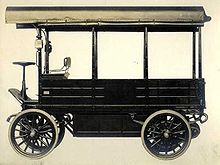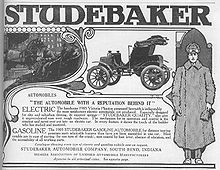Studebaker Electric
The Studebaker Electric was an electric car manufactured by the Brothers Manufacturing Company in South Bend, Indiana . The battery-powered cars were offered between 1902 and 1912.
description
Studebaker began making automobiles in 1898 when Frederick Samuel Fish , then President of Studebaker, got the owners' meeting to invest $ 4,000 in developing electric cars. Even without the full support of the owners, this project produced a car. The company also began manufacturing bodies for electrically powered taxis , which the Pope Manufacturing Company made.
Commercial production didn't begin until 1902, and the company chose battery-powered vehicles because they were clean, easy to charge, and worked well in larger cities without gas stations.
There was the Studebaker Electric with different structures that were often derived from the company's earlier carriage production, for example Stanhope , Victoria and Surrey . From 1904 there was a car with four seats.
Fish recognized early on that Studebaker's future was not in the electric car with all its limitations, but in the gasoline-powered vehicle. Studebaker's experience lay in wheelwright and vehicle sales, not so much in engine construction. This knowledge led to the founding of Studebaker-Garford in 1904 . The cooperation worked well until 1909/1910 Garford branched off chassis for the construction of his own automobiles and Studebaker came across the Everitt-Metzger-Flanders Company in Detroit while looking for an inexpensive car . EMF was to make the entire automobile and Studebaker wanted to sell it through its coach dealers.
Studebaker continued to manufacture electrically powered vehicles until John Studebaker , Fish's father-in-law, sought control of EMF in 1909 and actually achieved it in 1910.
In 1912, John Studebaker also saw that automobiles would have gasoline engines in the future, and so the small-scale production of electric cars ended. The official announcement of the reorganized Studebaker Corporation read:
- Electric vehicle manufacturing in South Bend has ended. It continued for over nine years without too much success, and eventually the superiority of the gasoline-powered car became apparent.
Web links
- oldcarbrochures.com: Studebaker Electric at Frank Leslie's Popular Monthly (January 1904 ) (accessed April 22, 2012)



